
The yellowfin tuna is a species of tuna found in pelagic waters of tropical and subtropical oceans worldwide.
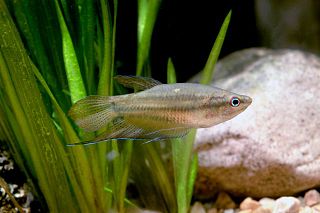
The croaking gourami is a species of small freshwater labyrinth fish of the gourami family. They are native to still waters in Southeast Asia and are distributed worldwide via the aquarium trade. Croaking gouramis are capable of producing a "croaking" noise using their pectoral fins.
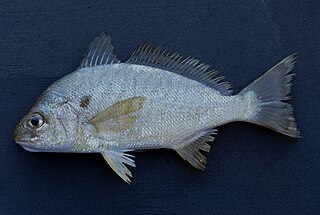
The spot, also known commonly as the spot croaker, Norfolk spot and the Virginia spot, is a species of small short-lived saltwater fish in the family Sciaenidae. The species inhabits estuary and coastal waters from Massachusetts to Texas, and derives its name from the prominent dark spot behind each gill. It is the only species in the genus Leiostomus. Spot are frequently caught by recreational anglers and are good to eat.

The California corbina, or California kingcroaker, is marine demersal fish in the croaker family. It can often be found along sandy beaches and in shallow bays. This species travels in small groups along the surf zone in a few inches of water to depths of 20 meters (66 ft). Other names include "California kingcroaker," "California whiting," and "kingfish".
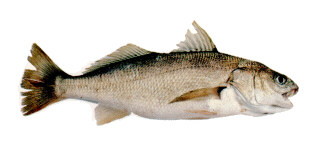
White croaker is a species of croaker occurring in the Eastern Pacific. White croakers have been taken from Magdalena Bay, Baja California, to Vancouver Island, British Columbia, but are not abundant north of San Francisco. White croakers swim in loose schools at or near the bottom of sandy areas. Sometimes they aggregate in the surf zone or in shallow bays and lagoons. Most of the time they are found in offshore areas at depths of 3 to 30 meters. On rare occasions they are fairly abundant at depths as great as 200 meters.
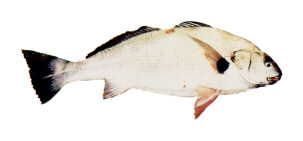
The spotfin croaker is a species of marine ray-finned fish belonging o the family Sciaenidae, the drums and croakers. This species occurrs from Mazatlán, Mexico, to Point Conception, California, including the Gulf of California. It is the only species in the genus Roncador. In California, they are most commonly found south of Los Angeles Harbor. They live along beaches and in bays over bottoms varying from coarse sand to heavy mud and at depths varying from 4 to 50 feet or more. They prefer depressions and holes near shore.

Bairdiella chrysoura, the American silver perch, silver croaker or goldtail croaker, is a species of marine ray-finned fish belonging to the family Sciaenidae, the drums and croakers. This species is widespread along the eastern cost of North Americaand is commonly caught by inshore anglers in search of larger species. This fish is common up to 20 cm (7.9 in), but can be found uncommonly to 30 cm (12 in).

The little tunny, also known as the false albacore, little tuna, bonita, or erroneously as the blue bonito, is a species of tuna in the family Scombridae. It can be found in the Atlantic Ocean and the Mediterranean and Black seas; in the western Atlantic, it ranges from Brazil to the New England states. The little tunny is a pelagic fish that can be found regularly in both offshore and inshore waters, and it is classified as a highly migratory species. The little tunny is best identified by the "worm-like" markings on its back and the dark spots appearing between its pectoral and ventral fins.
The striped croaker, also known as the St Lucian corvina, is a species of marine ray-finned fish belonging to the family Sciaenidae, the drums and croakers. This species is found in the western Atlantic Ocean in the Caribbean Sea and Gulf of Mexico.

The yellowfin whiting, also known as the western sand whiting or fine-scaled whiting, is a species of inshore marine fish in the smelt-whiting family Sillaginidae. The species is endemic to the eastern Indian Ocean, ranging from Dampier, Western Australia to Gulf St Vincent in South Australia, with an apparent division in the populations of the two states. Yellowfin whiting inhabit relatively shallow waters for their entire life, often found on tidal flats and creeks, as well as large estuaries. It is one of the largest members of the smelt-whiting family, growing to 42 cm, and can be distinguished by a number of anatomical and colour related features. Yellowfin whiting are benthic carnivores, preying predominantly on polychaete worms, with minor amounts of copepods, amphipods and bivalves also commonly taken. The species shows a change in diet with age, and also dietary differences with other sillaginids presumably to minimize competition. Reproduction occurs at different times throughout its range, generally focused around summer, with up to 217,000 eggs produced per season. Yellowfin whiting reach sexual maturity at around 20 cm, with each individual spawning more than once. The species forms the basis of major fisheries in both Shark Bay, Western Australia and the two Gulfs of South Australia, with around 260 tonnes of fish taken each year. They are also a popular target for shore based anglers, with a reputation as a very good table fish.
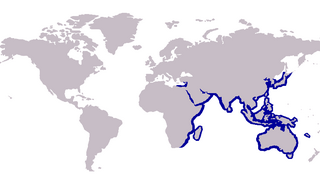
Smelt-whiting is the common name for various species of the family Sillaginidae. The Sillaginidae are distributed throughout the Indo-Pacific region, ranging from the west coast of Africa to Japan and Taiwan in the east, as well occupying as a number of small islands including New Caledonia in the Pacific Ocean. Well known members of this family include King George whiting, Japanese whiting, northern whiting, sand whiting and school whiting.

The California lizardfish is a species of lizardfish primarily inhabiting the Californian coast. It has a long, brown body, which offers it camouflage in its habitat, the sandy bottom of the ocean. From its hiding spot on the bottom it ambushes small fish and squid. California lizardfish are oviparous and are believed to spawn in the summer months.
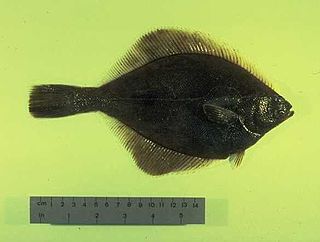
The yellowfin sole is a flatfish of the family Pleuronectidae. It is a demersal fish that lives on soft, sandy bottoms at depths of up to 700 metres (2,300 ft), though it is most commonly found at depths of around 91 metres (299 ft). Its native habitat is the temperate waters of the northern Pacific, from Korea and the Sea of Japan to the Sea of Okhotsk, the Bering Sea and Barkley Sound on the west coast of Canada. Males grow up to 49 cm (19 in) in length, though the common length is around 33.5 cm (13.2 in). The maximum recorded weight is 1.7 kg (3.7 lb), and the maximum recorded lifespan is 26 years.

Acanthogobius flavimanus is a species of fish in the goby family known by the common name yellowfin goby. Other common names include mahaze, Japanese river goby, Oriental goby, and spotted goby. It is native to Asia, where its range includes China, Japan, Korea, parts of Russia, Vietnam, and Malaysia. It has spread beyond its native range to become an introduced, and often invasive, species. It has been recorded in Australia, Mexico, and Florida and California in the United States.
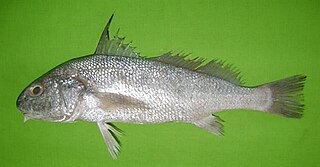
Johnius amblycephalus, the bearded croaker, also known as the green-backed croaker or sharp-nosed jewfish, is a marine ray-finned fish belonging to the family Sciaenidae, the drums and croakers. This fish is found in the Indian and Pacific Oceans.

Reeve's croaker, also known as the goldbelly croaker, golden corvina, yellowfin croaker or yellowfin corvina, is a species of marine ray-finned fish belonging to the family Sciaenidae, the drums and croakers. This species is found in the coastal waters of the Indo-Pacific region. It is the only species in the monospecific genus Chrysochir.

Umbrina canariensis, the Canary drum is a warm water, marine fish of the family Sciaenidae which is found in the western Mediterranean, eastern Atlantic Ocean and western Indian Ocean. Other English vernacular names are tesselfish, baardman, checker drum, common baardman, tasselfish and bellman.
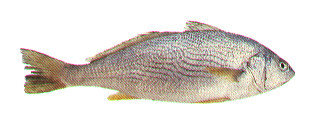
Umbrina is a genus of fish from the croaker family Sciaenidae. The genus contains 17 species occurring in tropical and warm temperate waters of the Atlantic, the Mediterranean, the Western Indian Ocean and the eastern Pacific.

Umbrina ronchus, the fusca drum, slender baardman, roncador, fusca croaker or slender tasselfish, is a species of croaker or drum from the family Sciaenidae which is found in the western Atlantic Ocean and the Mediterranean Sea.
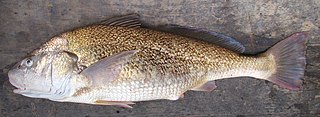
Micropogonias furnieri, the whitemouth croaker, golden croaker, hardhead, mangrove snapper, rocandoronco, two-belly bashaw, West Indian croaker, West Indian drum or whitemouth drummer, is a species of marine ray-finned fish belonging to the family Sciaenidae, the drums and croakers. This fish is found in the western Atlantic Ocean.





















